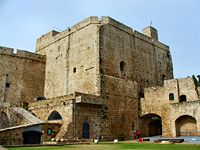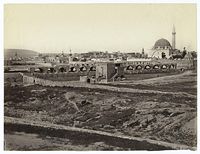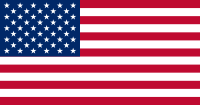Acre, Israel
| Acre | ||
|
||
| Hebrew | עַכּוֹ | |
| Arabic | عكّا | |
| Government | City | |
| District | North | |
| Population | 46,000 (2007) | |
| Jurisdiction | 13,533 dunams (13.533 km2/5.225 sq mi) | |
| Mayor | Shimon Lankry | |
Acre (Hebrew: עַכּוֹ, Ako; Arabic: عكّا, Akka)[1] also Akko, is a city in the Western Galilee region of northern Israel. It is situated on a low promontory at the northern extremity of Haifa Bay. According to the Israel Central Bureau of Statistics (CBS), Acre had a population of 46,000 at the end of 2007.[2] Historically Acre has been regarded as the key to the Levant due to its strategic coastal location.
Contents |
History
| Old City of Acre* | |
|---|---|
| UNESCO World Heritage Site | |
 |
|
| State Party | |
| Type | Cultural |
| Criteria | ii, iii, v |
| Reference | {{{ID}}} |
| Region** | Asia-Pacific |
| Inscription history | |
| Inscription | 2001 (25th Session) |
| * Name as inscribed on World Heritage List. ** Region as classified by UNESCO. |
|
The name Aak, which appears on the tribute-lists of Thutmose III (c. 1500 BC), may be a reference to Acre. The Amarna letters also mention a place named Akka.[3] In the Bible, (Judges 1:31), Akko is one of the places from which the Israelites did not drive out the Canaanites. It was in the territory of the tribe of Asher. According to Josephus, Akko was ruled by one of Solomon's provincial governors. Throughout the period of Israelite rule, it was politically affiliated with Phoenicia rather than the Philistines. Around 725 BC, Akko joined Sidon and Tyre in a revolt against Shalmaneser V.[4]
Greek and Roman periods
Greek historians refer to the city as Ake, meaning "cure." According to the Greek myth, Hercules found curative herbs here to heal his wounds. [5] Josephus calls it Akre. The name was changed to Antiochia Ptolemais shortly after Alexander the Great's conquest, and then to Ptolemais, probably by Ptolemy Soter, after the partition of the kingdom of Alexander the Great.[6]
Strabo refers to the city as once a rendezvous for the Persians in their expeditions against Egypt. About 165 BC Simon Maccabaeus defeated the Syrians in many battles in Galilee, and drove them into Ptolemais. About 153 BC Alexander Balas, son of Antiochus Epiphanes, contesting the Syrian crown with Demetrius, seized the city, which opened its gates to him. Demetrius offered many bribes to the Maccabees to obtain Jewish support against his rival, including the revenues of Ptolemais for the benefit of the Temple in Jerusalem, but in vain. Jonathan Maccabaeus threw in his lot with Alexander, and in 150 BC he was received by him with great honour in Ptolemais. Some years later, however, Tryphon, an officer of the Syrians, who had grown suspicious of the Maccabees, enticed Jonathan into Ptolemais and there treacherously took him prisoner.
The city was captured by Alexander Jannaeus, Cleopatra VII of Egypt and Tigranes II of Armenia. Here Herod built a gymnasium, and here the Jews met Petronius, sent to set up statues of the emperor in the Temple, and persuaded him to turn back. St Paul spent a day in Ptolemais (Acts 21:7). A Roman colonia was established at the city, Colonia Claudii Cæsaris.
After the permanent division of the Roman Empire in AD 395, Akko belonged to the Eastern (later Byzantine) Empire.
Arab rule and the Crusades

After the Byzantine army of Heraclius was destroyed by the Muslim army of Khalid ibn al-Walid at the Battle of Yarmouk and the Christian city of Jerusalem had capitulated to the Caliph Umar, the city came under the Rashidun Caliphate from 638, the Umayyad Caliphate and the Abbasid Caliphate until its capture by King Baldwin I of Jerusalem in 1104 in the First Crusade. The Crusaders made the town their chief port in Palestine. It was re-taken by Saladin in 1187, besieged by Guy of Lusignan in 1189 at the Siege of Acre, and again captured by Richard I of England in 1191. It then became the capital of the remnant of the Kingdom of Jerusalem in 1192. In 1229 it was placed under the control of the Knights Hospitaller. The Crusaders called the city "Acre" or "Saint-Jean d'Acre" since they mistakenly identified it with the Philistine city of Ekron, in northern Philistia, now southern Israel. It was the final stronghold of the Crusader state, and fell to the Mameluks of the Ayyubid Sultanate in a bloody siege in 1291.
Ottoman rule
- See also: Siege of Acre (1799)
The Ottomans under Sultan Selim I captured the city in 1517, after which it fell into almost total decay. Maundrell in 1697 found it a ruin, save for a khan (caravanserai) occupied by some French merchants, a mosque and a few poor cottages.[7]
Towards the end of the 18th century it revived under the rule of Dhaher al-Omar, the local sheikh: his successor, Jezzar Pasha, governor of Damascus, improved and fortified it, but by heavy imposts secured for himself all the benefits derived from his improvements. About 1780 Jezzar peremptorily banished the French trading colony, in spite of protests from the French government, and refused to receive a consul.
In 1799 Napoleon, in pursuance of his scheme for raising a Syrian rebellion against Turkish domination, appeared before Acre, but after a siege of two months (March–May) was repulsed by the Turks, aided by Sir Sidney Smith and a force of British sailors. Having lost his siege cannons to Smith, Napoleon attempted to lay siege to the walled city defended by Ottoman troops on 20 March 1799, using only his infantry and small-caliber cannons, a strategy which failed, leading to his retreat two months later on 21 May.
Jezzar was succeeded on his death by his son Suleiman, under whose milder rule the town advanced in prosperity till 1831, when Ibrahim Pasha besieged and reduced the town and destroyed its buildings. On 4 November 1840 it was bombarded by the allied British, Austrian and French squadrons, and in the following year restored to Turkish rule.
British Mandate

- See also: Acre Prison break
The province included the modern cities of Sidon, Tyre, Nabatiye, Nahariyya, and some other inland villages and towns such as Umm al-Faraj, Mazra'a, and Dayr al-Qassi.
The citadel of Acre was used by the British as a prison and as a location for a gallows. Many political prisoners, mainly Jewish underground movement activists, such as Zeev Jabotinsky and Shlomo Ben-Yosef, were jailed in the citadel-prison of Acre. Ben-Yosef, an Irgun activist, was the first Jew to be executed under the British mandate.
On May 4, 1947, the Irgun broke into the Acre citadel-prison in order to release Jewish activists imprisoned there by the British. Some 255 inmates escaped, the majority Arab.[8] Twenty-seven prisoners from armed Jewish groups escaped (20 from Irgun, seven from Lehi). In the immediate aftermath of the raid, nine were killed, and five attackers and eight escapees were captured.
Despite the heavy toll in human lives, the action was described by foreign journalists as "the greatest jail break in history." The London Haaretz correspondent wrote on May 5:
- "The attack on Acre jail has been seen here as a serious blow to British prestige... Military circles described the attack as a strategic masterpiece."
The New York Herald Tribune wrote that the underground had carried out "an ambitious mission, their most challenging so far, in perfect fashion." Of the five captured attackers, three who had been carrying weapons were tried and sentenced to death; the other two, minors who were unarmed when captured, received life sentences.[9]

After Israeli independence
In the 1947 UN Partition Plan, Acre was designated part of a future Arab state. When the Arabs rejected the plan and Israel declared its independence in 1948, leading to a war in which Israel was invaded by the surrounding Arab countries, Acre was besieged by Israeli forces. A typhoid fever outbreak in Acre at this time spurred Egyptian claims that the Haganah used typhus as a biological weapon against the inhabitants, and Brigadier Beveridge, chief of the British medical services, proclaimed that "Nothing like that ever happened in Palestine". According to New Historian Ilan Pappé, Subsequent investigation by Beveridge, Colonel Bonnet of the British army and delegates of the Red Cross concluded that the infection was caused by water-borne sources.[10] The Egyptians executed the Israeli soldiers they said were responsible, but Israel denies it has ever used biological weapons.[11][12] Acre was captured by Israel on May 17, 1948 and about three-quarters of its Arab population (estimated at 13,000 in 1944) became displaced as a result.
Demographics
Acre is in the process of demographic change. Today, Arab Israelis constitute about one-third of the population. According to Arab Israeli public figures, almost 70 percent of the residents in the old Mandatory district near the Old City are Arab Israelis. Only about 15 percent of the current Arab Israeli population descends from families who lived there before 1948.[13] Ethnic tensions erupted on October 8, 2008 turning into 5 days of violence after an Arab Israeli citizen drove through a predominantly Jewish neighbourhood during Yom Kippur.[14][15][16]
Conservation projects
Acre's Old City has been designated by UNESCO as a World Heritage Site. Since the 1990s, large-scale archeological excavations have been undertaken and efforts are being made to preserve ancient sites.

Sea walls
In 1750, Daher El-Omar, the ruler of Acre, utilized the remnants of the Crusader walls as a foundation for his walls. They were reinforced between 1775 and 1799 by Jezzar Pasha and survived Napoleon's siege. The wall was thin: its height was 10 to 13 metres (33 to 43 feet) and its thickness only one metre (3 ft).
A heavy land defense wall was built north and east to the city in 1800-1814 by Jezzar Pasha (called by the locals Al-Jezzar) and his Jewish advisor Haim Farhi. This wall is the first notable thing to come into sight when coming to Acre. It is a modern counter artillery fortification which includes a thick defensive wall, a dry moat, cannon outposts and three Burges (large defensive towers).

The sea wall, which remains mostly complete, is the original El-Omar's wall that was reinforced by al-Jezzar.
Jezzar Pasha Mosque
The Mosque of Jezzar Pasha was built by Jezzar Pasha in 1781. Jezzar Pasha and his successor Suleiman Pasha are both buried in a small graveyard adjacent to the mosque.
Hamam al-Basha
Built in 1795 by Jezzar Pasha, Acre's hammam has a series of hot rooms and a hexagonal steam room with a marble fountain. It is notable mainly because it was used by the Irgun as a bridge to break into the citadel's prison.
Citadel of Acre

The current building which constitutes the citadel of Acre is an Ottoman fortification, built on the foundation of the Hospitallerian citadel. The citadel was part of the city's defensive formation, reinforcing the northern wall. During the 20th century the citadel was used mainly as a prison and as the site for a gallows. During the British mandate period, activists of Jewish Zionist resistance movements were held prisoner there; some were executed there.
Today, the citadel of Acre contains the following:
- The Ottoman fortifications (including the tower and the moat).
- Acre Old City Visitor Centers.
- The "enchanted garden": a new garden that is planted according to historical description of the garden that was there during the Crusades period.
- Acre's British prison and the gallows.
- Memorial for Jewish resistance fighters executed during the British mandate.
- A Museum for the Jewish resistance prisoners, מוזיאון אסירי המחתרות .
- Prison cell of Bahá'u'lláh, Founder of the Bahá'í Faith.
- Knights' Halls (see below).
As of August 2004[update], the citadel is partly closed due to preservation work.
The Knights' Halls

Under the citadel and prison of Acre, archeological excavations revealed a complex of halls, which was built and used by the Hospitallers Knights. This complex was a part of the Hospitallers' citadel, which was combined in the northern wall of Acre.
The complex includes 6 semi-joined halls, one large hall (recently excavated), a dungeon, a dining room and remains of an ancient Gothic church. Medieval European remains include the Church of Saint George and adjacent houses at the Genovese Square (called Kikar ha-Genovezim or Kikar Genoa in Hebrew). There were also residential quarters and marketplaces run by merchants from Pisa and Amalfi in Crusader and medieval Acre)
Bahá'í holy places

There are many Bahá'í holy places in and around Acre. They originate from Bahá'u'lláh's imprisonment in the Citadel during Ottoman Rule. The final years of Bahá'u'lláh's life were spent in the Mansion of Bahjí, just outside Acre, even though he was still formally a prisoner of the Ottoman Empire.
Bahá'u'lláh died on May 29, 1892 in Bahjí, and his shrine is the most holy place for Bahá'ís — their Qiblih, the location that Bahá'ís should face when saying their daily obligatory prayers. It contains the remains of Bahá'u'lláh and is near the spot where he died in the Mansion of Bahjí.
Other Bahá'í holy places in Acre include the House of `Abbúd (where Bahá'u'lláh and his family resided) and the House of `Abdu'lláh Páshá (where later 'Abdu'l-Bahá resided with his family), and the Garden of Ridván where Bahá'u'lláh enjoyed spending the later part of his life.
On July 8, 2008, these holy places of the Bahá'í Faith, along with those in the nearby city of Haifa, were inscribed on the UNESCO World Heritage List, placing them alongside such sites as the Acropolis, the Taj Mahal, Vatican City, and the Old City of Jerusalem.[17] The Bahá'í shrines, however, "are the first sites connected with a relatively new religious tradition to be recognized by the World Heritage List."[18]
Sports
The city's major football team Hapoel Acre currently play in Liga Leumit, the second tier of Israeli football. They did play briefly in the top division during the 1970s, but have spent the majority of their history in the lower leagues.
Transportation
Acre has a central bus station which is served by Egged buses offering services within the city and extensive inter-city services to major cities and towns as Haifa, Nahariya, Karmiel, Safed, Kiryat Shmona, Sakhnin, as well as lines connecting it to nearby smaller villages. The city is also served by the Acre Railway Station.
Burials
- Heinrich Walpot von Bassenheim
- Otto von Kerpen
Sister cities
 Pisa, Italy
Pisa, Italy Bregenz, Austria
Bregenz, Austria Canton, Ohio, United States
Canton, Ohio, United States Deerfield Beach, Florida, United States [1]
Deerfield Beach, Florida, United States [1] Recklinghausen, Germany
Recklinghausen, Germany Bielsko-Biała, Poland
Bielsko-Biała, Poland
See also
- District of Acre
- Spring of the Cow
References
- ↑ Other spellings and historical names of the city include Accho, Acco and (Bahá'í orthography) `Akká, or formerly Aak, Ake, Akre, Akke, Ocina, Antiochia Ptolemais (Greek: Αντιόχεια της Πτολεμαΐδος), Antiochenes, Ptolemais Antiochenes, Ptolemais or Ptolemaïs, Colonia Claudii Cæsaris, and St.-Jean d'Acre (Acre for short)
- ↑ "Table 3 - Population of Localities Numbering Above 1,000 Residents and Other Rural Population". Israel Central Bureau of Statistics (2008-06-30). Retrieved on 2008-10-18.
- ↑ Burraburias II to Amenophis IV, letter No. 2
- ↑ Becking Bob (1992) The Fall of Samaria: An Historical and Archaeological Study BRILL, ISBN 9004096337 pp 31-35
- ↑ The Guide to Israel, Zev Vilnay, Ahiever, Jerusalem, 1972, p. 396
- ↑ "Acco, Ptolemais, Acre". BiblePlaces.com. Retrieved on 2008-10-20.
- ↑ Maundress, Henry (1836). A Journey from Aleppo to Jerusalem: At Easter, A.D. 1697. S. G. Simkins. pp. p. 90. http://books.google.com/books?id=LG09AAAAMAAJ&printsec=titlepage&source=gbs_summary_r&cad=0#PPA91,M1. Retrieved on 2008-10-20.
- ↑ "Acre Jail Break". Britain's Small Wars. Retrieved on 2008-10-20.
- ↑ Lapidot, Yehuda. "The Acre Prison Break". Jewish Virtual Library. Retrieved on 2008-10-20.
- ↑ Pappé, Ilan, The Ethnic Cleansing of Palestine (2007), p. 100
- ↑ "Typhoid - Biological Weapons". GlobalSecurity.org. Retrieved on 2008-10-20.
- ↑ "Israel: Biological Chronology". The Nuclear Threat Initiative. Retrieved on 2008-10-20.
- ↑ Stern, Yoav. "For Love of Acre". Haaretz. Retrieved on 2008-10-20.
- ↑ Khoury, Jack (2008-10-13). "Peres in Acre: In Israel There Are Many Religions, But Only One Law", Haaretz. Retrieved on 2008-10-20.
- ↑ Kershner, Isabel (2008-10-12). "Israeli City Divided by Sectarian Violence", New York Times. Retrieved on 2008-10-20.
- ↑ Izenberg, Dan (2008-10-12). "Police Arrest Acre Yom Kippur driver", The Jerusalem Post. Retrieved on 2008-10-20.
- ↑ "Baha’i Shrines Chosen as World Heritage sites", Baha'i World News Service (2008-07-08). Retrieved on 2008-10-20.
- ↑ Glass, Hannah (2008-07-10). "Israeli Baha'i Sites Recognized by UNESCO", Haaretz. Retrieved on 2008-10-20.
External links
- Old City of Acre - The Official Website (Old Acre Development Company - OADC )
- Acre's History (Jewish Virtual Library)
- The Acre prison break (Jewish Virtual Library)
- Acre travel home page (TripTouch.com)
- Names by which Acre has been known & pictures (Bibleplaces.com)
- Hazlitt's Classical Gazetteer
- Acre Walls (OADC)
- The Tourists Guide to Acre
- Photos of Acco
- Photo gallery of the old city of Acco
|
|||||||||||||
|
|||||||